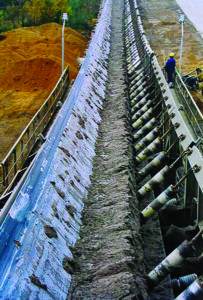Martin Engineering examines how – and why – to address conveyor belt mistracking.
With so many factors contributing to belt mistracking, perfectly centred alignment may not be possible for most conveyor systems. Everything from ambient temperature to changes in material grade can impact belt alignment, causing spillage and belt damage.
But mistracking is as much a safety issue as an efficiency and spillage issue, so monitoring belt drift to avoid contact with the structure is critical.
The Australian/New Zealand standard, AS/NZS 4024.3611-2015 – Conveyors, offers instructions to control belt wander in section 2.8.2.6. Tracking devices are required to stop excessive lateral movement that would allow uneven loading or where the belt might contact the stationary steel structure, which can cause spillage, frictional heating, or damage to the belt and/or structure.
The US Mining Safety and Health Administration (MSHA) attributes approximately 30 per cent of belt fires to friction caused by critical mistracking or belt slippage.

At the point of a fire, the telltale signs of mistracking – material spillage, belt and structural damage – were likely already occurring. When these signs are noticed, immediate tracking remediation is required before returning the system to production.
Failure to review and address causes of misalignment may result in permanent belt damage or even structural collapse. Temporary fixes are often employed but, for safety and long-term economic reasons, a permanent solution should involve a modern tracking system.
Operators need to know when misalignment becomes actionable and what to do about it. A new document from the Conveyor Equipment Manufacturers Association (CEMA), CEMA’s system mistracking allowance guide 2023, provides a comprehensive guide to identifying when the belt has drifted from normal operating tolerances into a serious workplace hazard.
Current standards
CEMA’s guide and the International Organization for Standardization (ISO) standards 14890 and 15236-1 are very similar in their recommendations for normal belt deviation from the central path. The CEMA guide is based on standard CEMA components and the ISO standards on the conveyor belt construction tolerances such as camber and troughability.
According to the ISO allowance, the conveyor belting, when running on a correctly aligned conveyor with centred loading, should not deviate from the central track by more than ±40mm for a belt width up to ≤800mm, or by more than ±5 per cent of the belt width of over >800mm with a maximum of ±75mm.
Allowable, actionable and critical mistracking
Allowable mistracking is the amount of design mistracking under normal conditions.
Some deviation from perfect tracking is bound to happen on any system, and the CEMA allowable tolerance was established for normal running conditions.
Actionable mistracking happens when operational or environmental factors influence belt tracking to the point where spillage or damage to the belt and/or structure occurs.
Best-in-class operators will plan action to correct this level of mistracking as soon as practical.
Critical mistracking is a second-level fault that creates an immediate and serious risk of substantial damage and injury to personnel. It must be corrected immediately to avoid additional spillage, belt or structural damage and other safety incidents.
System requirements for mistracking allowance
Consistent belt tracking is a system issue that must be addressed at every stage, from specifications to the conveyor’s initial design, installation, operation and maintenance.
The project specification should state the mistracking allowance as it affects the selection of the belting, structural clearances and rotating components.

Belt quality
The belting should be new and sourced from a manufacturer of high-quality equipment. Used belting will have wear, tear and stretching from its previous system, and low-quality belting may not be manufactured to Rubber Products Manufacturers Association or ISO requirements. Incorrectly specified belting might not trough properly, resulting in poor contact with the idlers.
Belt width
The width of the belt should be based on 85 per cent of the CEMA standard cross-sectional loading to allow for variations in loading and adequate free belt edge so the belt does not run out from under the sealing system.
Idler allowances
The CEMA mistracking allowances are based on standard CEMA idlers.
Consideration should be given to using offset return idler brackets, because the return run is lower in tension and the idlers therefore have less effect on maintaining a centre track and greater mistracking is possible.
Pulley allowances
The main pulleys should be selected so the belt doesn’t run off the face.
This may mean specifying a wider pulley face than a standard CEMA pulley.
Structural allowances
The structure should allow a free path for the belt, including the mistracking allowances.

Conveyor installation and retrofits
Installation of the conveyor structure and alignment of the rotating components are the foundations of a system designed to track properly.
When replacing a belt, components are often moved out of the way and not reset in the proper position. Mixing idler brands to save a few dollars or in search of the “perfect” idler can affect belt-to-idler contact and loading point spillage.
CEMA installation tolerances should be followed in the fabrication, erection and mounting of the rotating components. Benchmarks should be established, especially for the main pulleys, so in the event of chronic mistracking there is a reference for confirming the main pulleys are level and square as a starting point for correcting mistracking.
The same is true for resetting the idlers square to the centreline, as they are often haphazardly knocked and shimmed in an attempt to treat symptoms rather than root causes of mistracking.
Carrying side mistracking allowance
Carry side mistracking is usually not constrained by the idler roll length or load zone structural supports but rather by the possibility of spillage.
This feature appeared in the October 2023 issue of Australian Mining.

.jpg)

